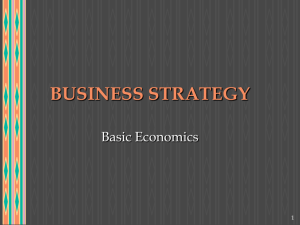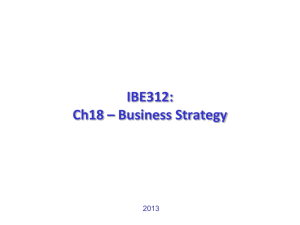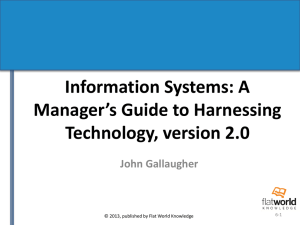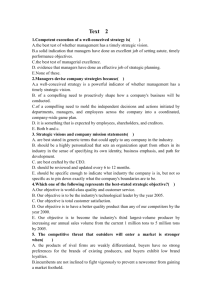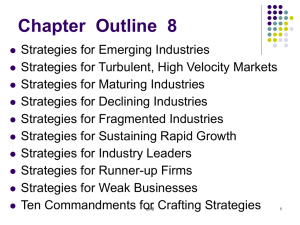Strategy Options
advertisement
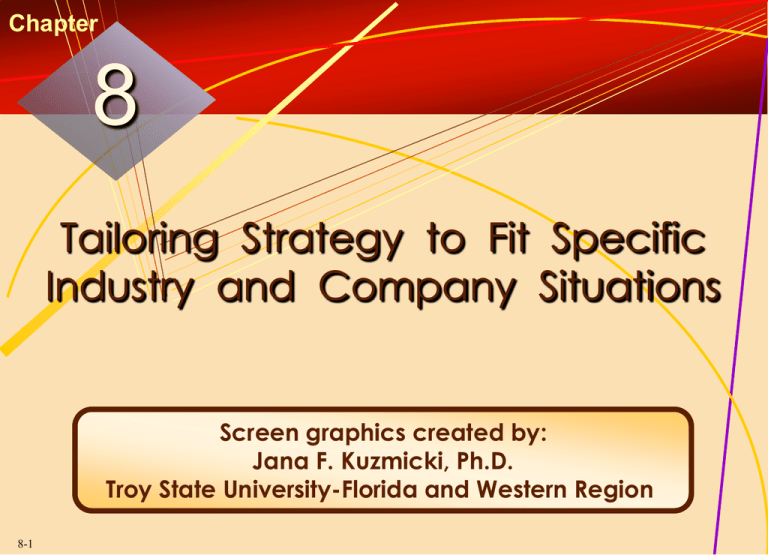
Chapter 8 Tailoring Strategy to Fit Specific Industry and Company Situations Screen graphics created by: Jana F. Kuzmicki, Ph.D. Troy State University-Florida and Western Region 8-1 Chapter Roadmap Strategies for Competing in Emerging Industries Strategies for Competing in Turbulent, High Velocity Markets Strategies for Competing in Maturing Industries Strategies for Firms in Stagnant or Declining Industries Strategies for Competing in Fragmented Industries Strategies for Sustaining Rapid Company Growth Strategies for Industry Leaders Strategies for Runner-up Firms Strategies for Weak and Crisis-Ridden Businesses Ten Commandments for Crafting Successful Business Strategies 8-2 Matching Strategy to a Company’s Situation Most important drivers shaping a firm’s strategic options fall into two categories 8-3 Nature of industry and competitive conditions Firm’s competitive capabilities, market position, best opportunities Features of an Emerging Industry New and unproven market Proprietary technology Lack of consensus regarding which of 8-4 several competing technologies will win out Low entry barriers Experience curve effects may permit cost reductions as volume builds Buyers are first-time users and marketing involves inducing initial purchase and overcoming customer concerns First-generation products are expected to be rapidly improved so buyers delay purchase until technology matures Possible difficulties in securing raw materials Firms struggle to fund R&D, operations and build resource capabilities for rapid growth Strategy Options for Competing in Emerging Industries Win early race for industry leadership by employing a bold, creative strategy Push hard to perfect technology, improve product quality, and develop attractive performance features Move quickly when technological uncertainty clears and a dominant technology emerges Form strategic alliances with Key suppliers or Companies 8-5 having related technological expertise Strategy Options for Competing in Emerging Industries (continued) Capture potential first-mover advantages Pursue New customers and user applications Entry into new geographical areas Focus advertising emphasis on Increasing Creating frequency of use brand loyalty Use price cuts to attract price-sensitive buyers 8-6 Features of HighVelocity Markets Rapid-fire technological change Short product life-cycles Entry of important new rivals Frequent launches of new competitive moves Rapidly evolving customer expectations 8-7 Fig. 8.1: Meeting the Challenge of High-Velocity Change 8-8 Strategy Options for Competing in High-Velocity Markets Invest aggressively in R&D Develop quick response capabilities Shift resources Adapt competencies Create new competitive capabilities Speed new products to market Use strategic partnerships to develop specialized expertise and capabilities Initiate fresh actions every few months Keep products/services fresh and exciting 8-9 Industry Maturity: The Standout Features Slowing demand breeds stiffer competition More sophisticated buyers demand bargains Greater emphasis on cost and service “Topping out” problem in adding production capacity Product innovation and new end uses harder to come by International competition increases Industry profitability falls Mergers and acquisitions reduce number of industry rivals 8-10 Strategy Options for Competing in a Mature Industry Prune marginal products and models Emphasize innovation in the value chain Strong focus on cost reduction Increase sales to present customers Purchase rivals at bargain prices Expand internationally Build new, more flexible competitive capabilities 8-11 Strategic Pitfalls in a Maturing Industry Employing a ho-hum strategy with no distinctive features thus leaving firm “stuck in the middle” Concentrating on short-term profits rather than strengthening long-term competitiveness Being slow to adapt competencies to changing customer expectations Being slow to respond to price-cutting Having too much excess capacity Overspending on marketing Failing to pursue cost reductions aggressively 8-12 Stagnant or Declining Industries: The Standout Features Demand grows more slowly than economy as whole (or even declines) Competitive pressures intensify – rivals battle for market share To grow and prosper, firm must take market share from rivals Industry consolidates to a smaller number of key players via mergers and acquisitions 8-13 Strategy Options for Competing in a Stagnant or Declining Industry Pursue focus strategy aimed at fastest growing market segments Stress differentiation based on quality improvement or product innovation Work diligently to drive costs down Cut marginal activities from value chain Use outsourcing Redesign internal processes to exploit e-commerce Consolidate under-utilized production facilities Add more distribution channels Close low-volume, high-cost distribution outlets Prune marginal products 8-14 Competitive Features of Fragmented Industries Absence of market leaders with large market shares Buyer demand is so diverse and geographically scattered 8-15 that many firms are required to satisfy buyer needs Low entry barriers Absence of scale economies Buyers require small amounts of customized or made-to-order products Market for industry’s product/service may be globalizing, thus putting many companies across the world in same market arena Exploding technologies force firms to specialize just to keep up in their area of expertise Industry is young and crowded with aspiring contenders, with no firm having yet developed recognition to command a large market share Fig. 8.2: Three Strategy Horizons for Sustaining Rapid Growth 8-16 Strategies Based on a Company’s Market Position Industry leaders Runner-up firms Weak or crisis-ridden firms 8-17 Industry Leaders: The Defining Characteristics Strong to powerful market position Well-known reputation Proven strategy Key strategic concern – How to sustain dominant leadership position 8-18 Strategy Options: Industry Leaders Stay-on-the-offensive strategy Fortify-and-defend strategy Muscle-flexing strategy 8-19 Types of Runner-up Firms Market challengers Use offensive strategies to gain market share Focusers Concentrate on serving a limited portion of market Perennial runners-up 8-20 Lack competitive strength to do more than continue in trailing position I’m trying! Strategic Options for Runner-Up Firms When big size provides larger rivals with a cost advantage, runner-up firms have two options Build market share Lower costs and prices to grow sales or Out-differentiate rivals in ways to grow sales Withdraw 8-21 from market Offensive Strategies for Runner-Up Firms Best “mover-and-shaker” offensives Pioneer a leapfrog technological breakthrough Get new/better products into market ahead of rivals and build reputation for product leadership Be more agile and innovative in adapting to evolving market conditions and customer needs Forge attractive strategic alliances with key distributors and/or marketers of similar products Find innovative ways to dramatically drive down costs to win customers from higher-cost rivals Craft 8-22 an attractive differentiation strategy Weak Businesses: Strategic Options Launch an offensive turnaround strategy (if resources permit) Employ a fortify-and-defend strategy (to the extent resources permit) Pursue a fast-exit strategy Adopt an end-game strategy 8-23 Achieving a Turnaround: The Strategic Options Sell off assets to generate cash and/or reduce debt Revise existing strategy Launch efforts to boost revenues Cut costs Combination of efforts 8-24 Liquidation Strategy Wisest strategic option in certain situations Lack of resources Dim profit prospects May serve stockholder interests better than bankruptcy Unpleasant strategic option 8-25 Hardship of job eliminations Effects of closing on local community What Is an End-Game Strategy? Steers middle course between status quo and exiting quickly Involves gradually sacrificing market position in return for bigger near-term cash flow/profit Objectives Short-term - Generate largest feasible cash flow Long-term 8-26 - Exit market When Should an End-Game Strategy be Considered? Industry’s long-term prospects are unattractive Building up business would be too costly Market share is increasingly costly to maintain Reduced levels of competitive effort will not trigger immediate fall-off in sales Firm can re-deploy freed-up resources in higher opportunity areas Business is not a major component of diversified firm’s portfolio of businesses Business does not contribute other desired features to overall business portfolio 8-27 10 Commandments for Crafting Successful Business Strategies 1. Always put top priority on crafting and executing strategic moves that enhance a firm’s competitive position for the long-term and that serve to establish it as an industry leader. 2. Be prompt in adapting and responding to changing market conditions, unmet customer needs and buyer wishes for something better, emerging technological alternatives, and new initiatives of rivals. Responding late or with too little often puts a firm in the precarious position of playing catch-up. 8-28 10 Commandments for Crafting Successful Business Strategies 3. Invest in creating a sustainable competitive advantage, for it is a most dependable contributor to above-average profitability. 4. Avoid strategies capable of succeeding only in the best of circumstances. 5. Don’t underestimate the reactions and the commitment of rival firms. 6. Consider that attacking competitive weakness is usually more profitable than attacking competitive strength. 7. Be judicious in cutting prices without an established cost advantage. 8-29 10 Commandments for Crafting Successful Business Strategies 8. Employ bold strategic moves in pursuing differentiation strategies so as to open up very meaningful gaps in quality or service or advertising or other product attributes. 9. Endeavor not to get “stuck back in the pack” with no coherent long-term strategy or distinctive competitive position, and little prospect of climbing into the ranks of the industry leaders. 10. Be aware that aggressive strategic moves to wrest crucial market share away from rivals often provoke aggressive retaliation in the form of a marketing “arms race” and/or price wars. 8-30
